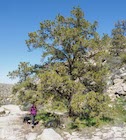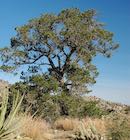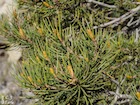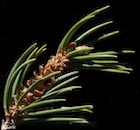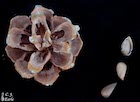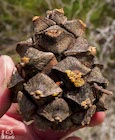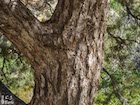Conservation Status

Pinus californiarum
D.K.Bailey 1987
Common names
Singleleaf piñon (or pinyon). Note that three taxa share this name: Pinus californiarum, P. × kohae, and P. monophylla. I propose calling it "California desert piñon" because it differs from other piñons of the USA in its exceptional tolerance of drought and high temperatures, and it is endemic to California (both the American and Mexican states). Indigenous names include tevat [Cahuilla] and ehwiiw [Kumeyaay], names which also apply to Pinus quadrifolia (source: display at Anza Borrego State Park).
Taxonomic notes
Type: United States, California, San Diego County, Anza-Borrego Desert State Park, Vallecito Mountains, northwest base of Whale Peak, 1280 m elevation, 33.05°N, 116.3333° W, Bailey 81-08 (iso MO, US). Synonymy:
- P. monophylla var. californiarum (D.K. Bailey) Silba 1990;
- P. monophylla subsp. californiarum (D.K. Bailey) Silba 2009.
As early as 1995, LaHood found that populations of P. edulis and P. californiarum share plastid DNA due to introgression. As detailed in the "Taxonomic notes" for P. monophylla, P. californiarum has a history of introgressive hybridization with all three other piñons of the region: P. monophylla on the north, P. edulis on the east, and P. quadrifolia in the southwest (Buck et al. 2023). The hybrid with P. edulis is named Pinus × kohae Frankis; see the P. edulis page for details.
Description
Trees. Leaves in fascicles of 1(-2), dark green, 40-58 × 1.2-1.4 mm, with 11-26 stomatal lines and 7-19 resin canals. Fascicle sheath 5-11 mm long, partly deciduous very early. Seed cones 4.5-6 cm across when open. Seeds 13-16 mm long with a 0.3-0.4 mm thick shell. Endosperm very oily (Silba 1990, Eckenwalder 2009).
See P. monophylla for how to distinguish P. californiarum from the other taxa of 1-needled piñon, and a discussion of how genetic mixing affects identification of these taxa in the field.
Distribution and Ecology
USA: California; Mexico: Baja California Norte; at elevations of 1280-2647 m. It has also been reported from S Clark County, Nevada, but based on analyses presented by Buck et al. (2023) those trees are almost certainly hybrids, introgressed by both P. monophylla and P. edulis. The IUCN does not yet recognize this taxon, but under their classification system it would likely qualify as "Least Concern" for human impacts due the very large extent of occurrence and the relatively light level of impacts currently being experienced.
Distribution map. Green represents P. monophylla, red is P. californiarum, purple is P. edulis, blue is P. × kohae, and orange is P. quadrifolia. Pinus californiarum, P. × kohae, and P. monophylla polygons by Cole (2003), based on a climate-calibrated habitat model. P. edulis and P. quadrifolia polygons by USGS (1999), based on professional judgement by E. L. Little. All point data from GBIF, DOIs = https://doi.org/10.15468/dl.twthv7 (P. californiarum), https://doi.org/10.15468/dl.7acmds (P. × kohae), https://doi.org/10.15468/dl.5unbjc (P. monophylla), and https://doi.org/10.15468/dl.qugjbg (P. quadrifolia); all accessed 2023.03.11. GBIF data processed to add coordinates based on narrative descriptions, and remove duplicates.
P. californiarum occupies lower, hotter, and drier environments than any other USA pine, and in particular experiences near-zero summer precipitation (Cole et al. 2008). Consequently, its hybrids with other piñons increase drought resistance by those taxa. This is particularly apparent in the case of P. edulis, which is normally our least drought-tolerant piñon and has suffered severe episodes of mortality during the 21st century in response to drought (Shaw et al. 2005, Hicke and Zeppel 2013, Meddens et al. 2015). Buck et al. (2023) explain that, compared to other piñons in the region, P. edulis occurs in higher elevation areas with precipitation during the summer months, while P. × kohae are in summer-wet areas that are drier by 12 mm and hotter by 2–4°C, showing that P. edulis and P. × kohae have different niches (Cole et al. 2008). Natural hybridization with P. californiarum "could facilitate the exchange of genes from more arid-adapted taxa into P. edulis, potentially allowing it to withstand the changing climate and prevent further die-off." Although it has not yet been demonstrated, improved drought tolerance may also be found in areas of hybridization with P. monophylla and P. quadrifolia.
This species, along with Pinus edulis, is host to the dwarf mistletoe Arceuthobium divaricatum (Hawksworth and Wiens 1996). Trees may also be afflicted by insects, but the majority of insect pests affecting other piñons seem not to have been recorded in this species, perhaps because of its exceptionally arid habitat. Similarly, no fungal diseases have been recorded (pest determinations based on GBIF.org inventories performed 2023.06.26).
A different perspective comes from Christensen et al. (1995), who studied vulnerability of P. × kohae, P. californiarum, and P. edulis to insect attack. Insect pests of these trees include the stem-boring moth Dioryctria albovittella, the scale insect Matsucoccus acalyptus, and several species of pitch moths that produce wounds on the trunk and branches. Stem-boring moths were significantly more abundant on P. × kohae than on either P. californiarum or P. edulis. Pitch moth wounds were more common on P. californiarum than on either P. × kohae or P. edulis. Scale insects were found only on P. × kohae. Christensen et al. interpret these findings as supporting the hybrid susceptibility and/or the stress hypothesis (the hybrid susceptibility hypothesis is that a hybrid has reduced disease resistance than either parent; the stress hypothesis is that species at the edge of their range suffer greater stress and are more susceptible to herbivory). However, the results could also be interpreted as related to the different climates to which these trees and insects are adapted.
Both piñon and juniper rely primarily upon birds to disperse their seeds. Piñons have a singular relationship with the birds that gather, cache and eat their seeds. The trees are completely dependent on these birds for seed dissemination. This relationship is wonderfully detailed in two books by Ron Lanner (Lanner 1981, 1996). Because the seeds are large and wingless, they cannot be disseminated by wind. Instead, the seeds are gathered by corvids, primarily the piñon jay (Gymnorhinus cyanocephalus), which will gather and cache huge numbers of seeds for consumption during the winter months. Some seeds are not recovered by the jays, and germinate to produce new seedlings. Piñon jays forage from green cones, and then from open cones as the season progresses. The jays may transport seeds up to 12 kilometers, and cache the seeds mainly in woodland areas, where successful regeneration may occur. Pinyon jays can carry an average of up to 56 seeds in an expandable esophagus, and most seeds are cached individually rather than in groups, so there is a good dispersal of the potential seedlings.
Remarkable Specimens
There are no published records. I found a tree in the Pinyon Mountains of California that was about 6 m tall with a 10 m crown spread and a low-forking trunk about 60 cm diameter below the fork; this is easily the largest of the hundreds I have seen.
Ethnobotany
Wilken (2012) details use of Pinus monophylla and P. quadrifolia by the Kumeyaay indians; the single-leaf piñon within their traditional range is not P. monophylla, but P. californiarum. He notes that the piñon was one of the most important foods for these people; "In late summer, the Kumeyaay, their neighbors the Ko’alh and the Paipai, regularly traveled to the great stands of pinyon to gather this highly prized and oil rich food," and that some Cucapá families also made the journey from the Colorado River desert to participate in the harvest. Harvest areas would be scouted in advance to determine the size of the crop, and which trees bore the most seeds; the harvest would sometimes last for weeks. The trees would be climbed, and the green cones cut and roasted in pits fueled by burning sagebrush (Artemisia tridentata), before removing the nuts. Later in the season, when the cones opened, harvesters would climb the trees and shake the branches to release the nuts; however an earlier harvest was preferred, before birds or rodents could forage the trees. The Kumeyaay would usually roast the nuts, though they could be eaten raw, and would sometimes grind the seeds on a metate and make them into a pinole, a gruel popular with people who lack teeth. The Cahuilla would commonly grind the nuts and make them into a drink or a mush. The Paipai would trade pine nuts for with peoples of the Colorado River desert region, or with merchants, in exchange for other types of food. There were also stories about the nuts: "During his 1948–49 fieldwork, Hohenthal (2001) recorded a story about a rock formation at Agua Hechicera (Ha ‘kusiyai) that resembled an open sack of pine nuts. According to his consultant María Osuna of the Kumeyaay settlement of Manteca, there was a big dance where a sack of shelled pine nuts was set on a rock for the guests to eat. When an uninvited guest thrust his hand in the sack, it turned to stone."
Observations
See the point locations on the map above.
Remarks
The epithet denotes the type location, in California.
Citations
Bailey, D. K. 1987. A study of Pinus subsection Cembroides. I: The singleneedle pinyons of the Californias and the Great Basin. Notes from the Royal Botanic Garden Edinburgh 44:275–310.
Buck, Ryan, Sandra Hyasat, Alice Hossfeld, and Lluvia Flores-Rentería. 2020. Patterns of hybridization and cryptic introgression among one- and four-needled pinyon pines. Annals of Botany 126(3):401–11. https://doi.org/10.1093/aob/mcaa045.
Buck, Ryan, Diego Ortega-Del Vecchyo, Catherine Gehring, Rhett Michelson, Dulce Flores-Rentería, Barbara Klein, Amy V. Whipple, and Lluvia Flores-Rentería. 2023. Sequential hybridization may have facilitated ecological transitions in the Southwestern pinyon pine syngameon. New Phytologist 237:2435–49. https://doi.org/10.1111/nph.18543.
Christensen, Kerry M., Thomas G. Whitham and Paul Keim. 1995. Herbivory and tree mortality across a pinyon pine hybrid zone. Oecologia 101:29-36.
Cole, Kenneth. 2003. Map sources for the ranges of one- and two-needled pinyons. http://sbsc.wr.usgs.gov/cprs/research/projects/global_change/RangeMaps/PinyonMapSources.pdf, accessed 2012.04.25.
Cole, Kenneth L., Jessica Fisher, Samantha T. Arundel, John Cannella, and Sandra Swift. 2008. Geographical and climatic limits of needle types of one- and two-needled pinyon pines. Journal of Biogeography 35:257-269.
Cole Kenneth L., J. F. Fisher, K. Ironside, J. I. Mead, and P. Koehler. 2013. The biogeographic histories of Pinus edulis and Pinus monophylla over the last 50,000 years. Quaternary International 310:96–110.
Hicke, J. A., and Zeppel, M. J. B. 2013. Climate-driven tree mortality: insights from the piñon pine die-off in the United States. New Phytologist 200(2): 301–303. doi:10.1111/nph.12464.
Hohenthal, William D., Jr. 2001. Tipai Ethnographic Notes: A Baja California Indian Community at Mid-Century.
Menlo Park, CA: Ballena Press and the Institute for Regional Studies of the Californias.
LaHood. E. 1995. A chloroplast DNA phylogeny of nine taxa in Pinus Cembroides subsection. MSc. thesis, Northern Arizona University, Flagstaff, Arizona, USA.
Meddens, A. J. H., Hicke, J. A., Macalady, A. K., Buotte, P. C., Cowles, T. R., and Allen, C. D. 2015. Patterns and causes of observed piñon pine mortality in the southwestern United States. New Phytologist 206(1): 91–97. doi:10.1111/nph.13193.
Montes, José‐Rubén, Pablo Peláez, Alejandra Moreno‐Letelier, and David S. Gernandt. 2022. Coalescent‐based species delimitation in North American pinyon pines using low‐copy nuclear genes and plastomes. American Journal of Botany 109(5):706–726. https://doi.org/10.1002/ajb2.1847.
Shaw, J. D., B. E. Steed, and L. T. DeBlander. 2005. Forest Inventory and Analysis (FIA) annual inventory answers the question: What is happening to pinyon-juniper woodlands? Journal of Forestry: 6:280-285.
Silba, J. 1990. Phytologia 68(1):54. Available: Biodiversity Heritage Library, accessed 2023.03.11.
Wilken, Michael Alan. 2012. An ethnobotany of Baja California's Kumeyaay indians. M.A. Thesis, San Diego State University.
See also
